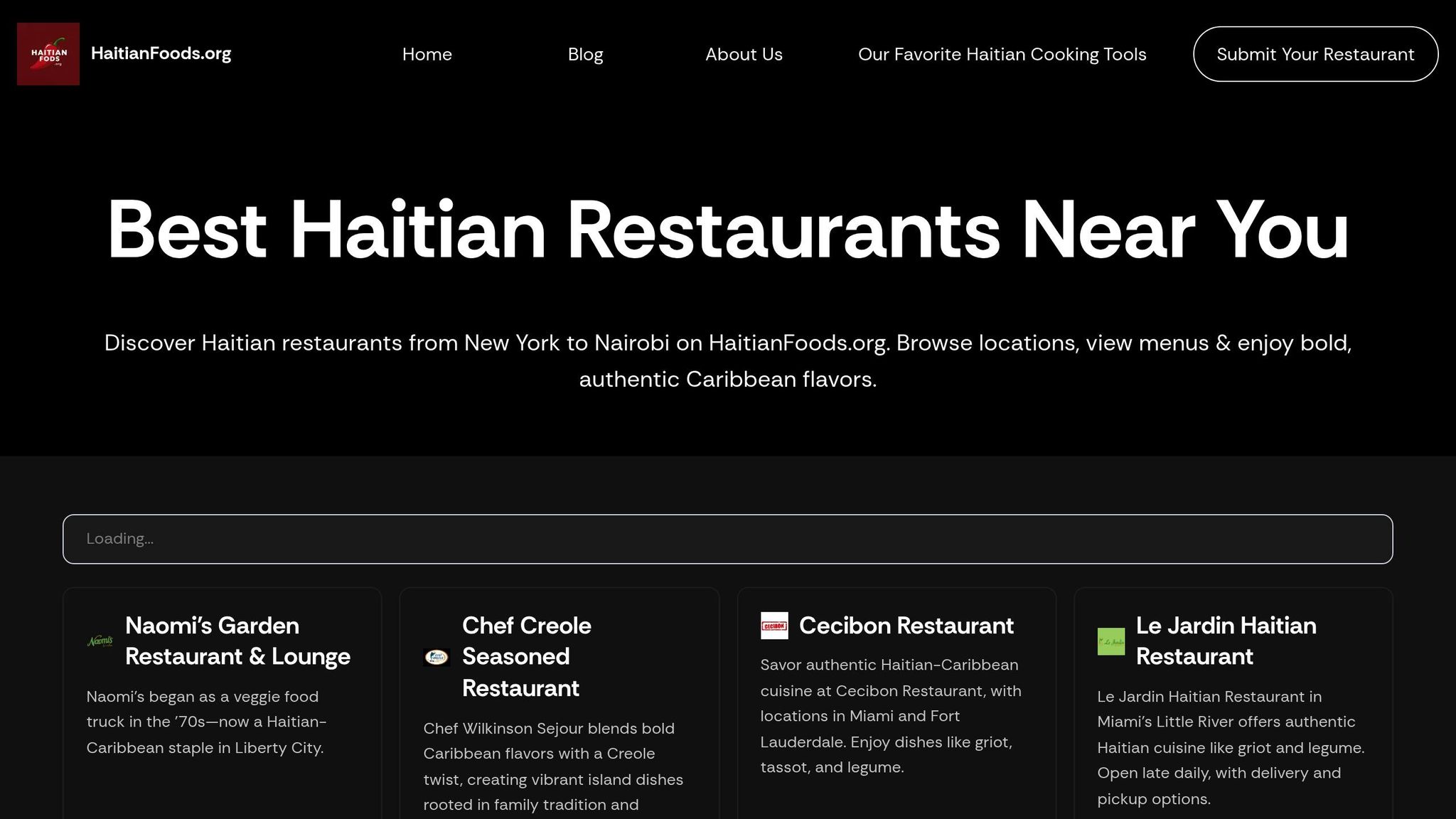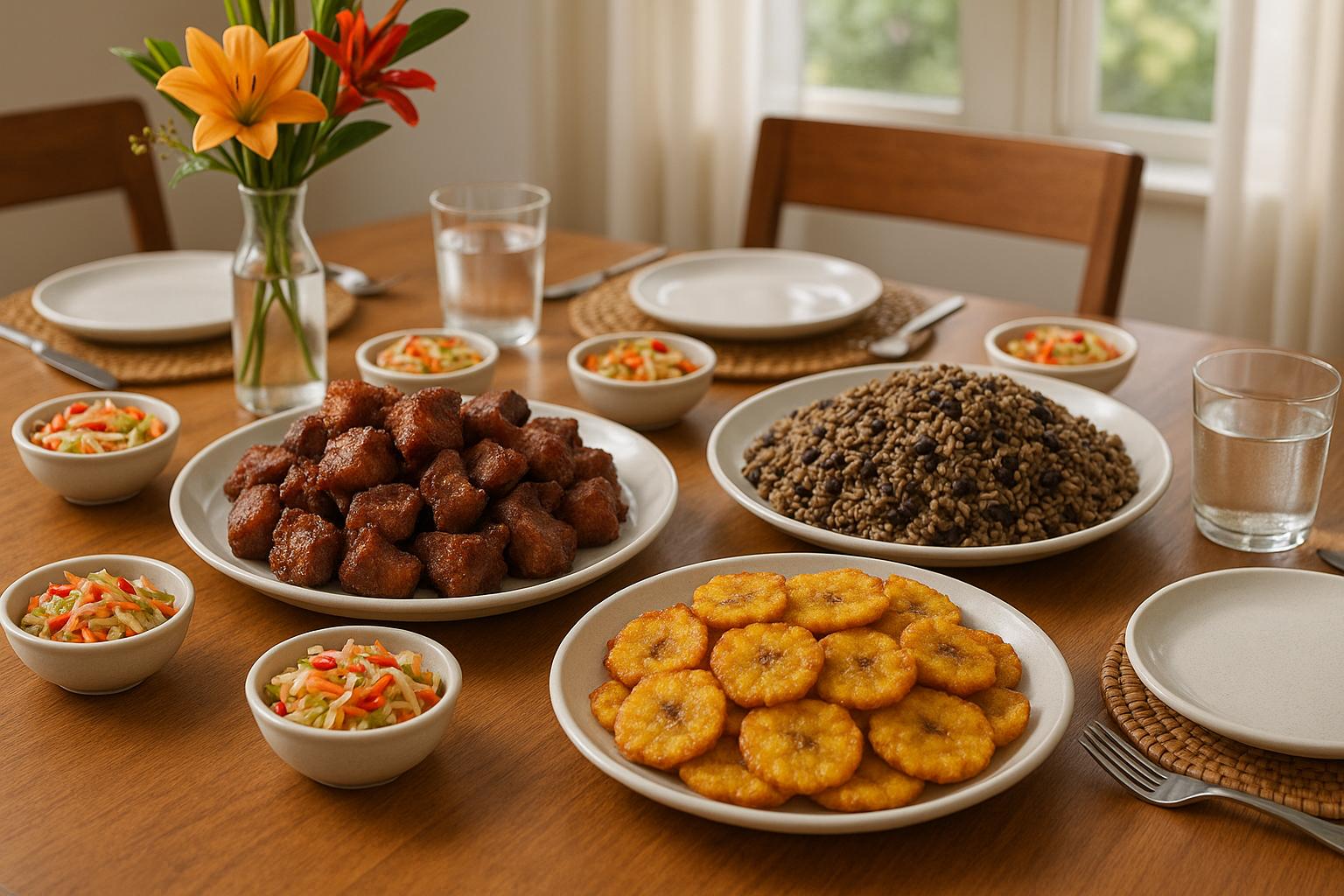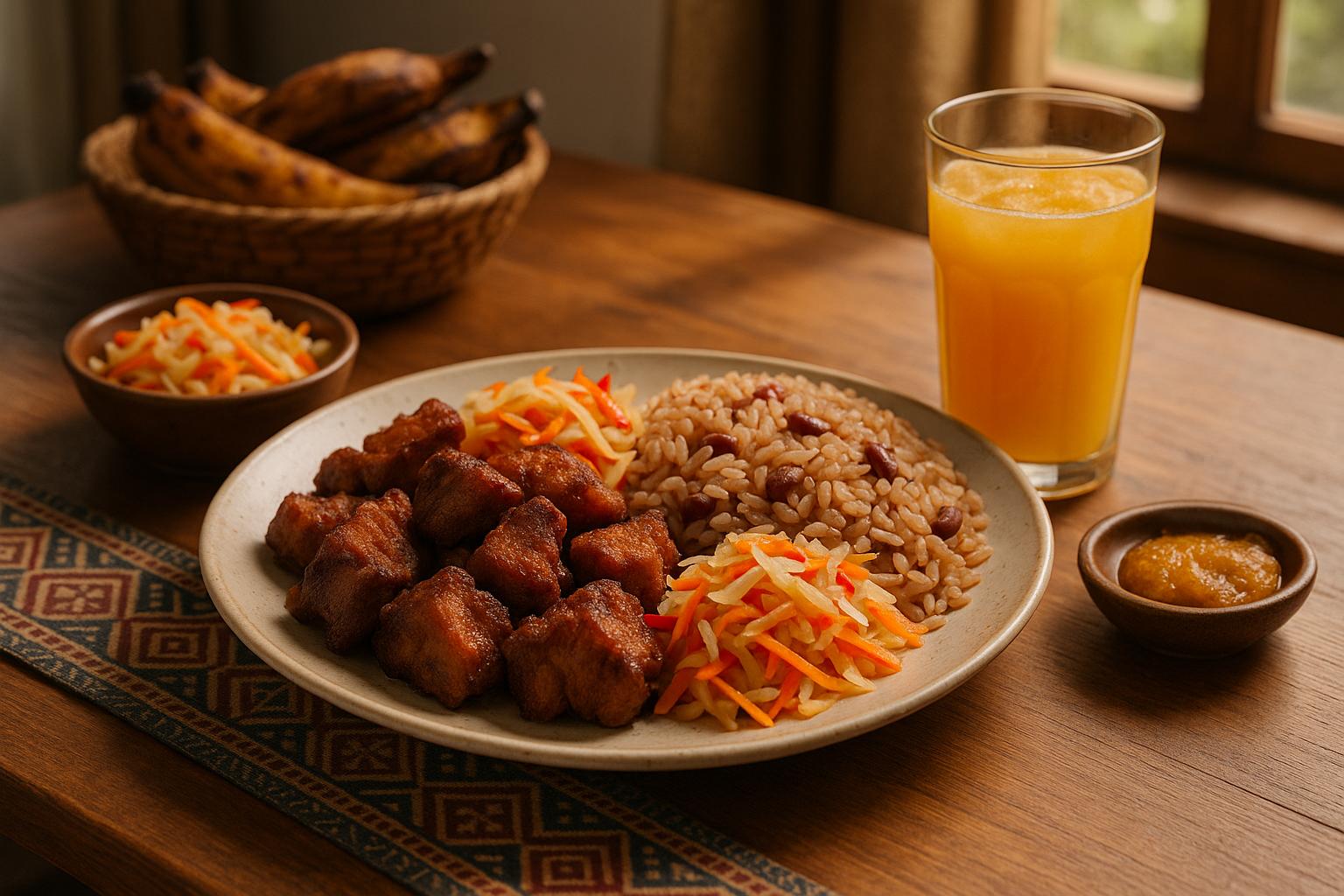Hidden Haitian restaurants across the U.S. act as more than just dining spots - they preserve recipes, traditions, and the rich history of Haitian cuisine. These eateries serve dishes like griot (fried pork), soup joumou (a symbol of Haiti's independence), and diri djon djon (rice with black mushrooms), showcasing the blend of African, French, Spanish, and Taíno influences that define Haitian cooking.
Owners face challenges like sourcing specific ingredients, navigating U.S. business regulations, and introducing unfamiliar customers to Haitian food. Yet, their passion drives them to share their heritage through food, creating spaces that connect communities and celebrate Haiti's legacy.
Platforms like HaitianFoods.org help diners find these hidden gems while supporting restaurant owners by promoting their stories and menus. Dining at these establishments offers an opportunity to experience the flavors and stories of Haiti firsthand.
Meet the Owners: How They Started Their Restaurants
From Haiti to the U.S.: Stories of Determination
For many Haitian restaurant owners in the U.S., their journey is a mix of challenges and hope. Take Juliano Jean Jules, for instance. Growing up in Haiti, he often found himself cooking for his siblings and cousins, sparking his dream of opening a restaurant. However, political instability eventually forced him to leave his homeland. He sought refuge in the U.S., eventually settling in Battle Creek, Michigan, where he opened Island Style BBQ [6].
Chef Tina, another Haitian migrant, fled Port-au-Prince after the tragic loss of her father. Now based in Massachusetts, she uses her culinary skills to run a weekly pop-up restaurant while she awaits her work permit [7].
The Haitian community in the U.S. has grown significantly over the years. In the late 1950s, about 500 Haitians immigrated annually. By 2000, the community had expanded to 750,000, with Florida hosting 268,000 Haitians and Massachusetts also seeing a large influx [8] [5].
For many, the transition to a new country stirs deep emotions. Ricardo Jean-Baptiste, a chef who made the journey, recalls the overwhelming feelings of nostalgia and connection:
"When I came here the first day, I'm almost crying because everything looks similar... It was like memories, memories running through my head." [4]
Cooking often becomes a bridge to their roots, helping immigrants stay connected to their heritage while navigating the complexities of immigration policies, language barriers, and building new lives in the U.S.
What Inspired Their Restaurants
The struggles and triumphs of these Haitian chefs fuel the passion behind their restaurants. For Chantal Quessa, owner of The Island in Malden, Massachusetts, the encouragement of family and friends who loved her "big Sunday dinners" led her to open her restaurant in April 2018. It became the first Haitian restaurant in Malden with a full bar, offering not just food but a vibrant atmosphere that celebrates Haitian culture [5].
"Everybody used to say, 'You do this all the time, why don't you make something out of it?'" Quessa recalls [5].
For many, their restaurants serve as more than just dining spots - they are cultural hubs. Chef Nathalie Lecorps, owner of Gourmet Kreyòl, explains her approach:
"For me, it's not only about eating the food, it's about experiencing the culture... You're going to tell me what you want to eat in Creole, because my menu is in Creole. And then under it, it's in English where we describe what each meal is so they can have an understanding." [3]
Stephan Berrouet Durand, founder of the Haitian Culinary Alliance, highlights the unifying power of food:
"I think food is universal and food brings people together. If you really want to teach someone anything about your culture, food is a driver for that." [3]
Chef Gregory Gourdet, chef-owner of Kann, emphasizes the emotional depth of Haitian cuisine:
"There's a very, very soulful savory cuisine that comes out of Haiti that really is good for everyone... Just like other cultures, we've been able to reclaim a lot of ingredients that were brought over through challenging situations." [3]
For Chef Tina, cooking is deeply personal - a way to feel connected to her homeland:
"When I make it, I feel home. I put myself entirely in it." [7]
Jean Appolon, owner of Jean Appolon Expressions, sees his work as a way to build community:
"Sharing is knowledge, and being able to come to dance together and share space together, it is something that will bring us closer to each other, and brings a community better." [5]
These restaurant owners see themselves not just as chefs, but as ambassadors of Haitian heritage. Through their food, they aim to honor the richness of Haitian cuisine while educating others about its history and significance [3].
Mom runs kitchen at Haitian restaurant on Long Island
Challenges Faced by Hidden Haitian Restaurants
Running a hidden Haitian restaurant in the U.S. comes with its own set of hurdles, beyond the usual demands of running a business. From sourcing authentic ingredients to navigating regulations and building community connections, these challenges require creativity and resilience.
Finding Real Haitian Ingredients
One of the toughest obstacles is sourcing genuine Haitian ingredients. Haiti’s internal infrastructure struggles to support efficient transport of food and agricultural products, making it difficult for restaurants to get what they need [12]. Ongoing security issues, including gang violence along key roads, further disrupt supply chains. Businesses often face steep fees to move goods or turn to maritime shipping as an alternative [11].
Despite these difficulties, efforts like those of HaiPro Distribution Inc., established in 2021, are making a difference. This company connects Haitian farms to both local and international markets, exporting staples like cassava from Cap Haitian, Diri Shella rice, Djon Djon mushrooms, Haitian chocolate balls, and Lalo (jute leaves) from the Artibonite Valley [10][13].
Haiti’s reliance on imports highlights the scale of the problem. In 2022, the country imported $279.34 million worth of rice, mostly from the U.S., and agricultural imports in 2021 totaled nearly $1 billion [12]. However, Haiti’s proximity to the U.S. offers some advantages. Maritime shipments can reach the U.S. in just three days, and frequent flights between Haiti and South Florida help maintain trade connections [11].
Dealing with Business Rules and Regulations
Sourcing ingredients is only part of the battle. Navigating the maze of U.S. business regulations presents another significant challenge. Restaurant owners must secure food service licenses, pass health inspections, and meet safety standards, all of which vary depending on the city [9]. For instance, cities like Denver, Indianapolis, and Philadelphia have relatively straightforward processes, while places like Washington, D.C., Seattle, and Boston are known for their more complex regulatory environments [14].
Starting a food truck, a popular choice for many Haitian entrepreneurs, can cost anywhere between $50,000 and $100,000. Out of that, approximately $28,276 is typically spent on permits alone [14]. Requirements include obtaining a business license, registering the truck, securing a food service license, and complying with strict health and safety standards [14]. Interestingly, 38% of food trucks are owned by immigrants, and 30% are run by women, reflecting the accessibility of this business model for Haitian restaurateurs [14].
Experts recommend starting the licensing process early and seeking professional advice to avoid costly mistakes [9]. But even with the legal and logistical challenges handled, another critical task remains: building a loyal customer base.
Building Community Support
Attracting customers to Haitian cuisine often means acting as more than just a restaurateur - it requires becoming a cultural ambassador. Owners use visual storytelling, such as high-quality photos and engaging designs, to showcase the vibrant flavors and textures of Haitian food [15]. They also host cultural events, cooking classes, and collaborate with local organizations to connect with the community [15]. These efforts not only draw in diners but also help preserve Haitian traditions.
Content marketing plays a big role here. Blog posts about Haitian culinary history, instructional cooking videos, and partnerships with local influencers can educate and inspire potential customers [15]. Encouraging user-generated content and tapping into diaspora networks also helps broaden their reach [15][17].
An inspiring example of community-driven support is the Centre Haitien du Leadership et de l'Excellence (CLE). In 2024, CLE organized the Chanpyon Lakay competition to honor five agricultural entrepreneurs working to improve food systems and strengthen local economies. This initiative was part of their Angaje program, which brought together 100 entrepreneurs - 65% of whom were women - for training and mentorship. Winners were announced in March 2025 and received cash prizes to support their ventures [16].
Balancing these challenges means Haitian restaurant owners must juggle many roles: chef, business manager, cultural storyteller, and supply chain expert. Through it all, they strive to keep the authentic flavors and traditions of Haitian cuisine alive.
sbb-itb-80c33ff
Signature Dishes and Their Meaning
Haitian restaurants bring their heritage to life through signature dishes - each one telling a story that connects diners to Haiti's rich history and traditions.
Special Menu Items
Take Griot, for example. This dish features tender pork, slow-cooked after being marinated in epis - a signature spice blend that’s at the heart of Haitian cooking [3]. Then, it’s fried to perfection, creating a crispy exterior while staying juicy inside. Griot is often paired with pikliz, a fiery pickled vegetable relish that adds a tangy punch, or a refreshing cabbage salad [18].
Sandrika Balthazar, the owner and head chef of Haitian Food RVA, describes how she uses epis, habanero peppers, and Maggi spices to craft the bold, unforgettable flavors that define Haitian cuisine [2].
"I love Haitian food. Period. It's like, you're eating the food, you're thinking about it, you feel the love." [2]
Another standout is Diri Djon Djon, a rice dish that owes its dark color and earthy flavor to black mushrooms native to Haiti [18]. These mushrooms give the dish its distinctive aroma, while spices like clove and star anise add warm, sweet notes [18].
Then there’s Soup Joumou, a dish loaded with history. This pumpkin soup is more than a meal - it’s a symbol of freedom and independence. After Haiti’s victory over Napoleon’s army in 1803, the formerly enslaved people celebrated their independence on January 1, 1804, with Soup Joumou. Once forbidden during slavery, it became a powerful emblem of liberation [19][21]. The soup combines influences from West African, New World, and French cuisines, reflecting Haiti’s layered cultural identity [21].
Chef Alain Lemaire captures the spirit of Haitian food perfectly:
"Haitian food is very rich, flavorful; it's bold, fresh and in your face. It is the heart of what we represent because food for us is not only about nutrition, but it brings everybody together. Every celebration involves food. It's about unity and strength." [20]
These dishes do more than satisfy hunger - they serve as windows into Haiti’s culinary and cultural traditions.
Teaching Customers About Haitian Food
Haitian cuisine isn’t just about taste; it’s an invitation to explore history and heritage. Every dish tells a story, offering diners a chance to learn about the ingredients, techniques, and traditions behind it.
Restaurant owners often see themselves as both chefs and cultural educators. Chef Nathalie Lecorps of Gourmet Kreyòl uses her menu as a way to teach customers about Haiti’s language, traditions, and stories [3].
"For me, it's not only about eating the food, it's about experiencing the culture... It's a learning experience for my customers." [3]
Gregory Gourdet, chef-owner of Kann, echoes this sentiment:
"There's tons of educating. A lot of people hadn't had Haitian food before. So we are doing our part to highlight [Haitian] ingredients and share the stories of these ingredients." [3]
This emphasis on storytelling helps diners understand that Haitian cuisine is about more than just bold flavors - it’s about reclaiming ingredients and traditions that have endured through colonization and slavery [3]. Haitian cooking brings together influences from African, French, Spanish, and indigenous Taíno cultures. Staples like rice, beans, plantains, and aromatic herbs form the base, while spices create its signature bold taste [1].
Stephan Berrouet Durand, founder of the Haitian Culinary Alliance, highlights the unifying power of food:
"I think food is universal and food brings people together. If you really want to teach someone anything about your culture, food is a driver for that." [3]
Maintaining authenticity while making dishes approachable can be a challenge. Reflecting on her journey, Sandrika Balthazar shares:
"I was taking down the spice of the culture, what the people loved the food for... So, I cook my food the way I was raised to be cooking it." [2]
Every dish is a doorway into Haitian culture, preserving the traditions and flavors that make this cuisine so compelling.
Supporting Haitian Restaurants and Food Heritage
Hidden Haitian restaurants play a vital role in preserving Haiti's rich cultural heritage while connecting diverse communities. These establishments are more than just dining spots - they serve as cultural hubs where traditional Haitian music, art, and food come together to create meaningful experiences. They offer a taste of Haiti’s vibrant legacy and provide an opportunity to educate and unite people from all walks of life [25]. By supporting these restaurants, we help bridge the gap between time-honored Haitian recipes and the ever-evolving culinary landscape.
As Chef Stephan Durand eloquently puts it:
"What we have is our culture. Cuisine is part of that culture. This is what Haiti has. If they see us as proud, talented then people start seeing us as artists they can get to know us better." [24]
Backing these establishments not only preserves Haitian traditions but also celebrates the creativity and resilience that define Haitian cuisine.
Finding Restaurants with HaitianFoods.org

Finding authentic Haitian restaurants can be tricky, especially since many are tucked away in local neighborhoods. That’s where HaitianFoods.org steps in. This global directory connects food lovers with authentic Haitian cuisine, making it easier to discover hidden gems [23].
The platform provides detailed listings of Haitian restaurants worldwide, highlighting their signature dishes and unique offerings. Whether you're craving griot, diri djon djon, or soup joumou, HaitianFoods.org helps you find restaurants that stay true to traditional cooking methods and ingredients [22].
Beyond restaurant listings, the site offers a blog filled with recipes, cultural stories, and dining tips. It’s a resource that not only guides diners but also deepens their appreciation for the history and artistry behind Haitian food.
Helping Restaurant Owners
HaitianFoods.org isn’t just for diners - it’s a lifeline for restaurant owners. Many hidden Haitian restaurants struggle with visibility, relying heavily on word-of-mouth to attract customers. By listing on HaitianFoods.org, these businesses can reach a broader audience eager to experience authentic Haitian flavors [23].
The platform does more than promote businesses; it celebrates the stories behind them. Restaurant owners can share their personal journeys and the family traditions that inspire their menus, building deeper connections with their patrons. It’s a way to highlight the passion and hard work that go into keeping Haitian culinary traditions alive.
As Sandrika Balthazar of Haitian Food RVA encourages:
"I believe everyone should try it and make the decision themselves, to see if they like it or not. Everyone deserves a chance." [2]
Conclusion: Celebrating Hidden Haitian Food Places
The stories of hidden Haitian restaurant owners reveal that food nourishes more than just the body - it preserves identity, strengthens community ties, and keeps traditions alive. Through dishes like griot, pikliz, and soup joumou, these owners showcase the resilience and pride that are at the heart of Haitian culture.
As Chef Alain Lemaire puts it:
"It means everything to me, because it is the essence of who I am, what I represent, and my heritage. Haitian culture is vibrant, full of stories and history." [26]
These restaurants do more than serve meals - they offer a window into Haiti’s rich culinary heritage. Every dish tells a story, shaped by African, Indigenous, French, Spanish, and Arab influences. By supporting these eateries, diners become part of a larger effort to safeguard a living cultural legacy.
The challenges these owners face - like sourcing traditional ingredients and raising awareness - make their achievements even more inspiring. Their dedication ensures that recipes and cooking techniques are passed down, keeping the connection to ancestral roots alive for Haitian communities across the U.S.
Nadege Fleurimond emphasizes this beautifully:
"Haitian food culture expresses identity and resilience - a legacy of storytelling, pride, and community." [26]
Platforms like HaitianFoods.org amplify these efforts, helping food enthusiasts discover authentic Haitian restaurants while giving these hidden gems the recognition they deserve. By making these places more accessible, we ensure that future generations can continue to enjoy the warmth, hospitality, and vibrant flavors that define Haitian cuisine.
Dining at a hidden Haitian restaurant is more than a meal - it’s a celebration of cultural heritage and the hardworking individuals who bring it to life.
FAQs
What challenges do Haitian restaurant owners in the U.S. face when sourcing authentic ingredients?
Haitian restaurant owners in the U.S. often struggle to source key ingredients that give their dishes their signature flavors. Items like traditional spices, fresh tropical fruits, and other specialty products are either missing from mainstream grocery stores or only available at niche markets, which can be both expensive and inconvenient to access.
To tackle these obstacles, many owners get creative. They might collaborate with specialty suppliers, arrange for direct imports, or tweak recipes while working hard to maintain the authentic essence of Haitian cuisine. Their commitment ensures that diners can experience the rich and vibrant flavors that make Haitian food so special.
How do Haitian restaurant owners use their menus to share Haitian culture with customers?
Haitian restaurant owners design their menus with care, aiming to offer diners more than just a meal - they provide a window into Haiti's rich history and traditions. Dishes like griot (flavorful fried pork) and soup joumou (a pumpkin soup deeply tied to Haiti's fight for freedom) carry stories of strength, independence, and cultural pride.
These menus often go beyond listing ingredients, including detailed descriptions that highlight the cultural roots of each dish. Some even feature Creole phrases or symbols that celebrate Haiti's identity. This thoughtful touch not only introduces diners to the flavors of Haitian cuisine but also immerses them in its heritage, making each dining experience a journey into the heart of Haitian culture.
How do hidden Haitian restaurants support the Haitian community and keep their culture alive in the U.S.?
Hidden Haitian restaurants do more than just serve food - they help keep Haitian heritage alive and strengthen community ties. These cozy spots offer authentic Haitian dishes that let people reconnect with their roots and celebrate their culture. They often host events and gatherings, turning into hubs where the Haitian community can come together, share stories, and feel a sense of belonging.
But their impact goes beyond the Haitian community. These restaurants act as gateways to Haiti’s vibrant traditions and history, giving others a chance to experience its rich culture through food and hospitality. By preserving traditional recipes and creating spaces for connection, they play a key role in fostering pride and unity among the Haitian diaspora.


